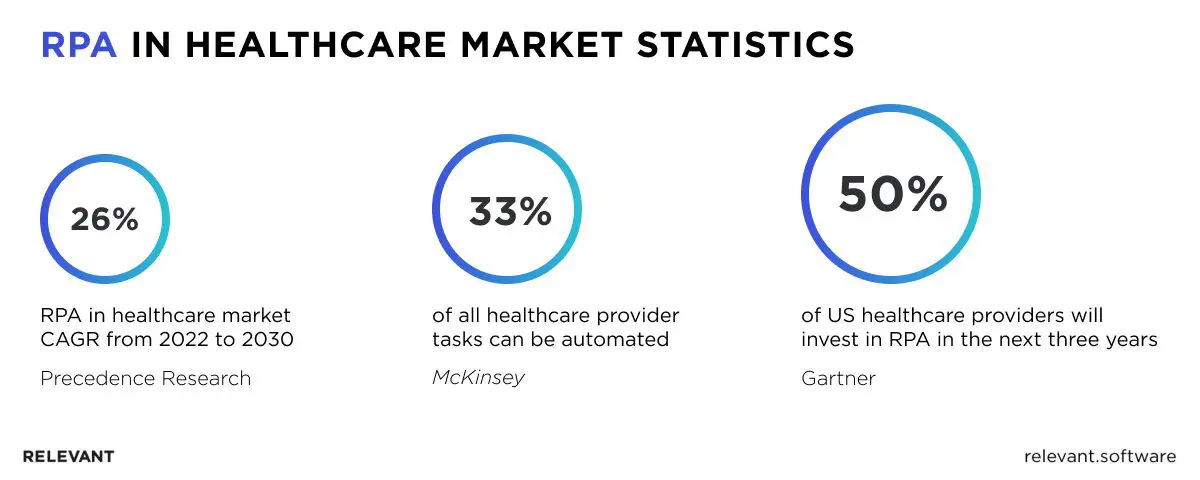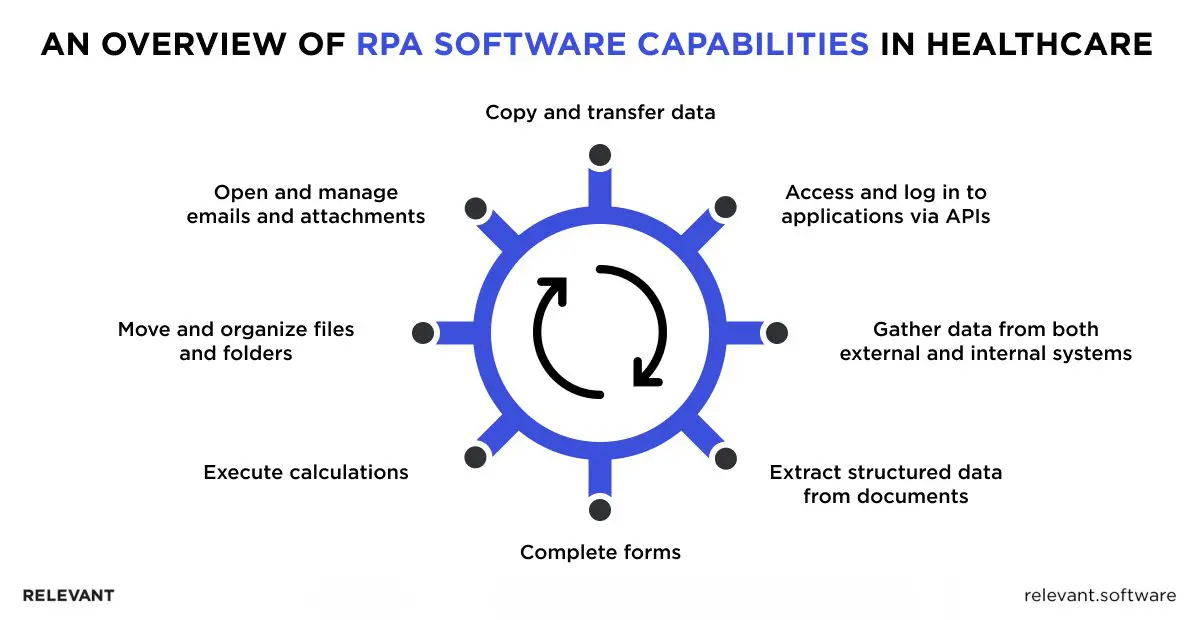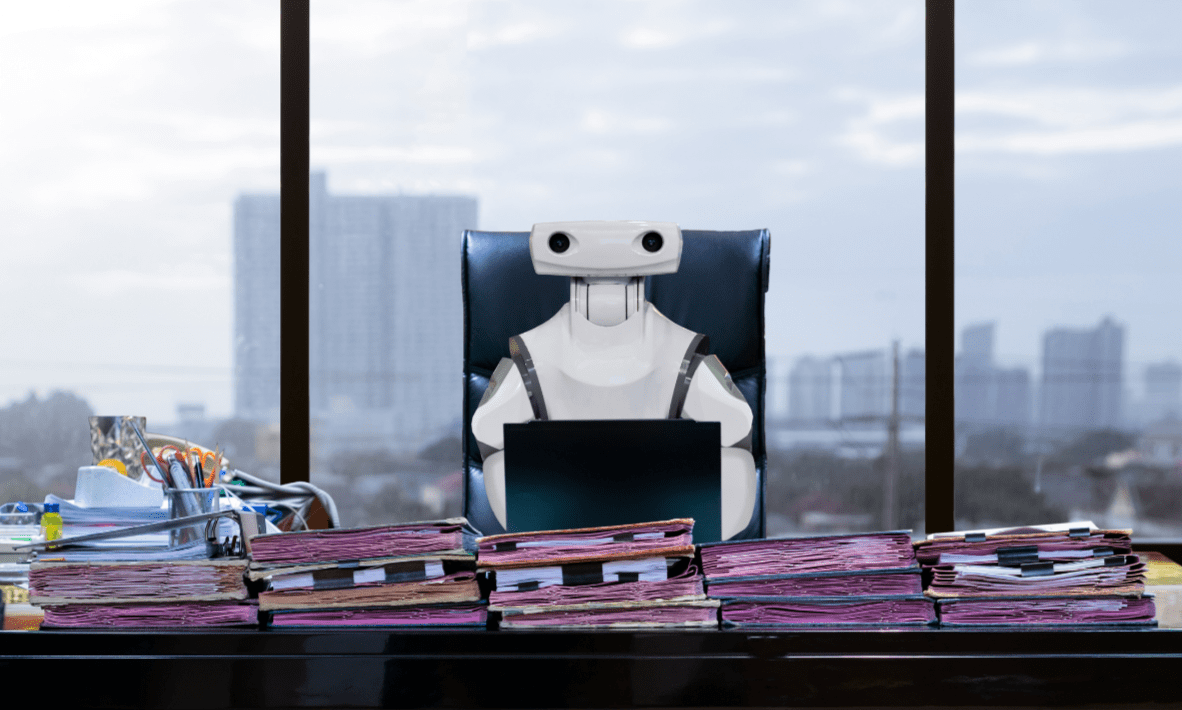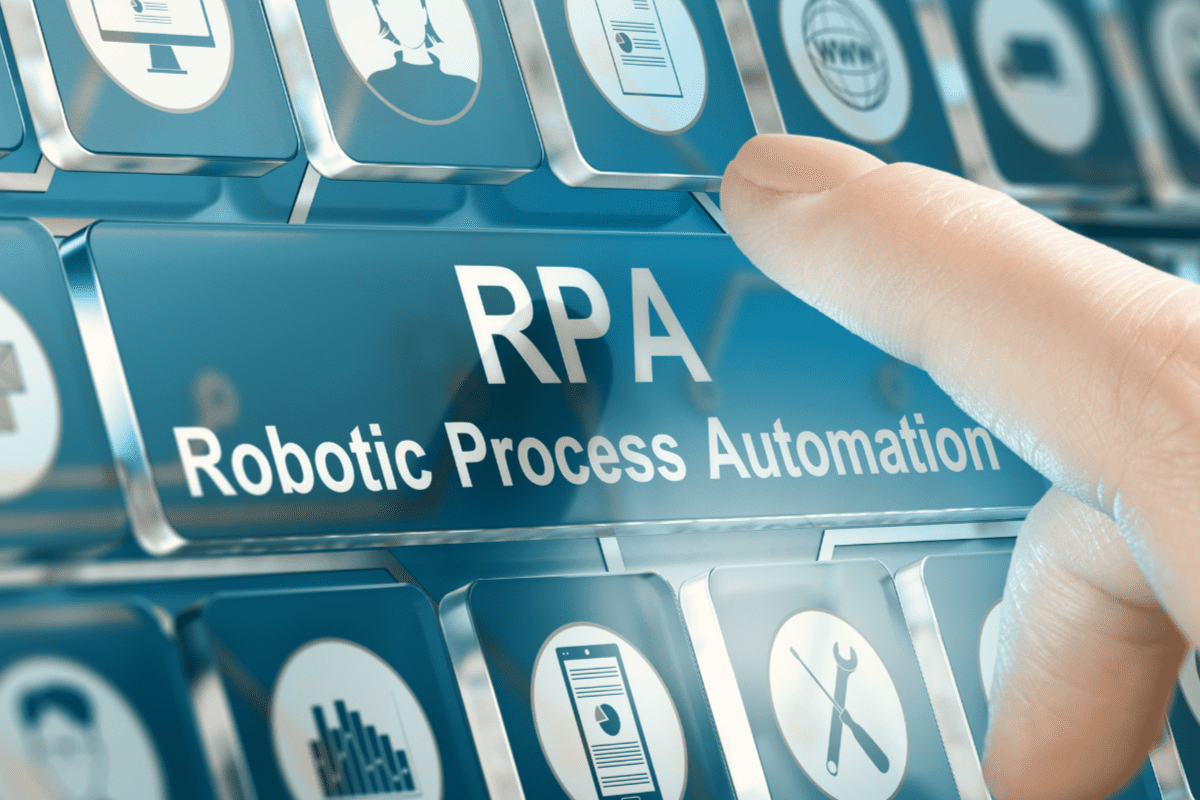Robotic Process Automation in Healthcare: an Exploration

Healthcare currently faces an unprecedented efficiency crisis. Pressure on healthcare providers is mounting, with an anticipated shortage of 37,800 to 124,000 physicians over the next decade. Administrative tasks such as schedule management, claims processing, and billing eat up a lot of time, are prone to mistakes, and distract physicians from patient care. Yet, the situation isn’t as bleak as it might seem. Broad adoption of robotic process automation in healthcare could address many of the inefficiencies that are painful to the medical system. But what is RPA in healthcare, and why do you need to invest in RPA services to succeed?
We’ll explore all the details and focus on its benefits, practical uses, and real examples of RPA applications in healthcare.
What is Robotic Process Automation (RPA)?
We all understand that every second matters in healthcare. However, tedious, error-prone tasks slow operations and affect costs, compliance, and patient satisfaction. Critical data from clinical applications, lab reports, insurance portals, scheduling tools, and HR applications is often fragmented, which hinders seamless communication between them. Moreover, the integration of these systems is typically complex, forcing healthcare organizations to depend on manual, repetitive work from staff.
Robotic Process Automation offers a solution. This software uses APIs and user interfaces (UI) to perform repetitive tasks, activities, and transactions across different applications. These operations are carried out automatically by scripts, which ensure efficiency and consistency without manual intervention.
RPA’s significance in healthcare is profound. It directly addresses the industry’s urgent need for efficiency and accuracy. According to a survey by AKASA™, nearly 78% of healthcare systems have either implemented or are in the process of RPA implementation for their revenue cycle activities. Gartner predicts that this number could rise to 50% within three years, and 20% of all doctor-patient interactions will involve some form of artificial intelligence, up from 3% today.

How RPA Works
Traditional IT-based process automation aims to transform systems for increased efficiency, sometimes disrupting current IT architectures. In contrast, Robotic Process Automation (RPA) requires minimal IT changes and does not interrupt the fundamental core. RPA bots access systems like humans through the user interface with established access controls, so no major system overhaul is needed.
RPA automates tasks that mainly involve structured data and logical operations. It uses a business rules engine to make decisions based on pre-defined criteria. When combined with artificial intelligence (AI), RPA evolves into intelligent automation (IA) or cognitive automation, which replicates human abilities through bot-driven processes.

AI’s Influence on RPA and Vice Versa
As more businesses embrace Robotic Process Automation (RPA), there is a debate about its relationship with Artificial Intelligence (AI). RPA automates repetitive, rule-based tasks without learning from its experiences. Additionally, an RPA bot requires human intervention to adapt if a web form changes.
On the other hand, AI technologies, such as deep neural networks, can learn and adapt over time. AI can perform complex data analysis, make predictions, and recognize patterns without explicit instructions, and it goes beyond simple automation by improving through experience and data exposure. For instance, AI can analyze patient health records to predict potential health issues and offer insights that will enhance over time.
Combining RPA and AI in healthcare involves the integration of machine learning (ML) models to enhance decision-making in automated workflows. This integrated approach enables more dynamic and intelligent automation, as well as more accurate management of a wider range of tasks.
“RPA, meaning medical automation, involves using bots to handle repetitive, rule-based tasks triggered by specific events.”
Vadim Struk, Product Manager at Relevant Software
Key Components of RPA Systems
Several key components designed to maximize efficiency and reliability are at the core of any robust RPA and healthcare system. These components are composed of layers, each with specific functions:
RPA Recorder
The RPA Recorder captures user actions on the computer screen, such as keystrokes, mouse clicks, and navigation between applications. It translates these actions into a script that the RPA bot can use to automate tasks. This component is essential because it can accurately replicate human actions and ensure the reliability of automation processes.
RPA Designer
The RPA Designer is a sophisticated software program that enables users to create, edit, and manage RPA bots. It typically provides a visual interface for building bots through drag-and-drop pre-built actions or coding custom scripts. Advanced designers also provide support for complex logic, conditional statements, and integration with other software development tools, thereby enhancing flexibility and capability.
Robot Control Unit
The Robot Control Unit serves as the central hub for managing, monitoring, and deploying RPA bots. It allows users to schedule bot operations, track performance in real time, and troubleshoot errors. The control unit often includes features for load balancing, which ensures efficient bot operations across different workloads and environments.
RPA Bots
RPA Bots are software robots that execute automated tasks. They are programmed to interact with various applications, such as web browsers, enterprise applications, and databases. Advanced bots can perform complex tasks, like data extraction, transaction processing, and workflow automation, and often mimic human actions with high accuracy.
Integration Tools
Integration Tools enhance RPA system capabilities by connecting them with other advanced technologies. For example:
- Optical Character Recognition (OCR): Enables bots to extract data from documents and images and converts unstructured data into structured formats.
- Artificial Intelligence (AI): Enhances bots’ intelligence and adaptability and allows them to make decisions, understand natural language, and learn from data patterns.
- API Integrations: Allow bots to communicate with various software systems and platforms, which ensures seamless data flow and operational coherence.
Security Features
Security Features are critical for safe and compliant RPA system operations. These features include:
- Access Control: Restricts access to the RPA system based on user roles and permissions.
- User Authentication: Verifies the identity of users before allowing them access to the system.
- Audit Logging: Tracks and records all bot activities and user interactions and provides a detailed log for monitoring and compliance purposes.
- Data Encryption: Protects sensitive data throughout storage and transmission and ensures that confidential information remains secure.
Scalability and Maintenance Options
Effective RPA systems are designed to scale with organizational needs. They should handle increasing volumes of tasks without performance degradation. Additionally, constant support and maintenance are essential. Regular updates, troubleshooting, and technical support ensure the system’s continuous optimal performance and adaptability to changes in the organizational environment.
Reporting and Analytics
These tools are key for healthcare providers to extract actionable insights from RPA operations. They optimize workflows, pinpoint inefficiencies, and support data-driven decisions to enhance service delivery. Advanced analytics can predict trends and propose improvements, which ensures continuous enhancement of healthcare services.
These components ensure an RPA system is efficient, reliable, adaptable, and secure, catering to the diverse needs of modern healthcare environments.

Benefits of Robotic Process Automation in Healthcare
Robotic Process Automation in healthcare industry offers prospective results. According to a Deloitte global survey, organizations that used RPA achieved a return on investment in less than a year, with an average increase of 20% in full-time equivalent capacity. Respondents highlighted benefits such as cost reductions, enhanced compliance, improved task accuracy, and increased employee productivity. We will consider the most notable of them in more detail.
Reduced Administrative Workload
When we discuss RPA (meaning medical), it’s important to note its impact on improving workflow efficiency. The application of RPA in healthcare industry can tackle the mountain of administrative tasks that often burden healthcare professionals.
Traditionally handled manually, software robots can now complete these duties swiftly and accurately. That frees valuable time for clinicians to focus on direct patient care, such as detailed consultations and examinations. For instance, a doctor who previously spent 30 minutes per day to check insurance can now dedicate that time to patients.
Streamlined Repetitive Tasks
RPA handles repetitive tasks with high accuracy, removes tedium, and reduces the potential for errors associated with manual data entry and processing. For example, automating the creation of discharge summaries ensures a consistent format and includes key patient information such as diagnoses, medications, and follow-up instructions.
Minimized Human Errors
Human error is an inevitable component of manual processes. Process Improvement Institute states that humans tend to commit at least 10 errors per 100 steps. This is largely because repetitive tasks become monotonous and typically result in decreased attention and higher error rates. In contrast, RPA bots are designed to handle these tasks with precision.
Unlike humans, bots do not experience boredom or fatigue, and they perform their tasks without emotional influence. For example, RPA can automatically extract data from medical charts for billing purposes and reduce errors compared to manual entry. This translates to fewer errors in critical areas and reduced costs associated with the correction of mistakes.
Optimized Resource Allocation
RPA streamlines workflows and automates tasks, which allows healthcare organizations to optimize resource allocation. This ensures effective staff deployment, which enhances productivity and overall efficiency.
For instance, RPA can automatically schedule appointments based on physician availability and patient needs, which minimizes wait times. Healthcare organizations can reallocate these resources to other areas, like hiring additional nurses or investments in modern medical equipment.
Faster Processing of Patient Information
RPA automates data entry and processing tasks, which leads to faster turnaround times for patient information. For instance, lab results can be uploaded directly into patient charts, which allows quicker diagnoses and the development of treatment plans.
With RPA, patient data gets updated in real-time, which means no more delays or outdated information. Data flows smoothly across different healthcare systems, making sure doctors and nurses have all the info they need right at their fingertips. This immediate access helps them make better decisions and coordinate care more effectively.
RPA also helps spot patterns and trends in patient data that might not be obvious at first glance. This results in early detection of potential health issues and timely intervention.
Ensured Regulatory Compliance
Healthcare operates under strict regulations. RPA can adhere to compliance protocols and align data management and record-keeping processes with all regulatory requirements. This minimizes the risk of non-compliance penalties and safeguards patient privacy. For example, RPA can automate the generation of detailed audit trails for all patient interactions, ensuring adherence to HIPAA regulations.
RPA systems maintain consistent documentation practices, which reduces the likelihood of human error in record-keeping. They automatically update patient records, track consent forms, and ensure all required documentation is complete and accurate. This thoroughness supports regulatory audits and inspections, providing clear and precise records on demand.
Additionally, RPA can monitor changes in regulatory requirements and update processes accordingly, ensuring continuous compliance. Through integration with electronic health records (EHR) systems, RPA handles patient data securely and restricts access to authorized personnel only.
Reduced Labor Costs
By automating repetitive tasks, RPA reduces the need for manual labor. For example, with automated appointment systems, a receptionist can now focus on patient intake and create a more hospitable experience. With RPA for healthcare, medical organizations can complete labor-intensive tasks 60% faster while cutting associated costs by up to 80% and then reallocating these resources to other areas.
Advanced RPA tools can integrate with available healthcare IT systems, which ensures seamless operation without extensive overhauls. This adaptability ensures that organizations can implement RPA solutions quickly and start seeing cost reductions almost immediately
More Time for Patient Interaction
One of the most significant benefits of RPA is the increased time it allows for patient interaction. A physician can now spend less time on paperwork, truly listen to patient concerns, and create personalized treatment plans.
When automation takes care of administrative tasks, healthcare workers can dedicate more time to patient interactions, offer personalized care, and meet specific needs. This change usually results in higher patient satisfaction and improved health outcomes.
Applications of Robotic Process Automation in Healthcare
Here’s a closer look at specific areas with a deeper dive into each application of RPA in healthcare industry:
Appointment Scheduling and Management
Scheduling and managing appointments pose a repetitive and time-consuming challenge for healthcare support staff daily. They communicate with patients to determine physician availability, change appointment times or locations, send reminders, inform them about cancellations, and reschedule bookings.
RPA can automate these tasks by interacting with patients by phone or email, offering appointment slots, booking them, and updating the database without staff involvement. Bots can manage a large volume of appointments and send reminders faster and more accurately. It seamlessly integrates with electronic health records (EHRs) to identify available time slots that consider current patient appointments, physician schedules, and even procedure durations.
Medical Records and Documentation
RPA automates report generation, data summarization, and medical record updates based on pre-defined rules. For instance, RPA can automatically generate discharge summaries that include key patient information, medications, and follow-up instructions. This not only frees up clinicians from tedious administrative tasks but also ensures complete and accurate documentation for improved care continuity. Additionally, RPA for healthcare can be programmed to automatically update medication lists within EHRs when prescriptions are filled or adjusted, which minimizes the risk of medication errors.

Inventory Tracking & Management
A nurse spends about 6,000 hours each year looking for misplaced equipment, which wastes valuable time that could be used for patient care. The inability to efficiently locate assets can increase wait timesб, delay critical treatments, and negatively impact patient care.
Combining Robotic Process Automation with digital sensors and cloud-based control panels enables staff to easily locate equipment, verify inventory accuracy, and monitor asset conditions to ensure timely replacements. This can be achieved by linking with inventory management systems or RFID tags on medical supplies. When stock levels reach pre-defined reorder points, RPA can trigger purchase orders automatically, which ensures timely replenishment and prevents stockouts that could disrupt patient care. This approach optimizes resource allocation, minimizes waste, and reduces unnecessary inventory holding costs.
Patient Data Management
RPA in healthcare ensures data accuracy and consistency by automating data entry from various sources, such as patient registration forms, lab results, and physician notes, into EHRs. Additionally, RPA can automate data cleansing and validation processes.
For instance, it can identify and flag duplicate patient records or inconsistencies in demographic information, which allows staff to address these issues efficiently. This comprehensive and accurate patient data empowers clinicians to make informed decisions about treatment plans and facilitates better care coordination across different departments and specialties.
Billing and Claims Processing
Nearly 91.2% of Americans, or around 300 million people, have health insurance coverage. Managing these insurance claims falls to healthcare providers and involves data input, process, evaluation, and handling appeals. Manual or generic software methods often result in inefficiencies and errors, with more than 30-40% of claims being denied due to non-compliance with regulations.
RPA intelligently scans physician notes by optical character recognition (OCR), discharge summaries, and other documents to extract relevant information for coding and billing purposes. Also, RPA automatizes claim submission to insurance companies, significantly expedites the reimbursement process, and improves cash flow for healthcare organizations.
Recent RPA use cases in healthcare show that such systems verify health insurance claim statuses in just 12 seconds, compared to 85 seconds for a human. This means one robot can perform the tasks of nine full-time employees without errors. According to McKinsey, RPA in medical insurance can reduce claims processing costs by 30% for companies that automate 60-70% of actions associated with claims administration.
Automated Reminders and Follow-ups
Robotic Process Automation healthcare automates patient outreach, which boosts engagement and adherence to treatment plans. It can send appointment reminders through email, text messages, or voice calls.
RPA can also handle tasks such as notifying patients about medication refills and post-discharge follow-ups. This helps improve patient care coordination. Healthcare providers can set up personalized messages so patients receive timely information and support throughout their healthcare journey.
Procurement & Logistics
RPA improves procurement processes by taking over repetitive tasks such as generating purchase orders based on reorder points from the inventory management system. It can also automate communication with vendors by sending out requests for proposals and managing follow-up emails.
Additionally, RPA can track order fulfillment by monitoring shipment information and notifying relevant staff of any delays or issues. This automation improves procurement efficiency, reduces administrative costs associated with manual processes, and ensures the timely delivery of essential medical supplies.
Telehealth and Virtual Assistance
RPA meaning medical improvements in telehealth platforms to automate appointment scheduling for virtual consultations. This allows patients in remote areas or with limited mobility to easily book appointments with healthcare providers from home. Additionally, as RPA manages patient flow in virtual waiting rooms, patients see their virtual providers promptly. Furthermore, RPA offers basic virtual assistance throughout consultations and automates tasks such as gathering basic patient information or arranging follow-up appointments.
As you can see, RPA healthcare systems perfectly automate routine work, which increases efficiency and precision and reduces costs. Organizations that understand the value of RPA well can leverage it to refine their operations and strengthen their market position.
Challenges of Robotic Process Automation in Healthcare
Implementing Robotic Process Automation in healthcare presents several pressing challenges that organizations must solve to fully leverage its benefits.
Cyber Security
Securing healthcare data poses a critical challenge due to the sensitive nature of patient information. In the US, over 13 million healthcare records are stolen and sold annually, primarily due to human errors in the security chain. Ensuring that robotic process automation healthcare systems follow regulations like HIPAA, use advanced encryption, and enforce strict access controls is essential to protect patient data from breaches and unauthorized access.
Voluminous Data Processing
Healthcare organizations manage vast amounts of data, such as patient records, lab results, insurance details, and billing information. Manual processing of this data is labor-intensive and prone to errors. Legacy systems often store this data in isolated formats, which complicate integration and access. To automate data tasks with RPA, careful preparation is essential to ensure accurate data extraction, validation, and integration with available systems. The complexity of handling diverse data sources and formats adds to this challenge.
Curbing Escalating Costs
Healthcare providers face a dual challenge: they must reduce operational costs while maintaining high-quality care and boosting revenues. Real-time operations make resource optimization difficult without jeopardizing service quality. While RPA healthcare systems can help to automate repetitive administrative tasks, the initial investment and maintenance costs can be substantial. Organizations must ensure that the cost savings from automation justify these investments and contribute to long-term financial sustainability.
Staff Volatility
Within the next five years, the healthcare sector will face a shortage of over 3.2 million lower-wage healthcare workers, such as medical assistants and home health aides. This shortage threatens to lower the quality of healthcare services and increase the strain on existing staff. An RPA medical system can mitigate this issue by automating routine tasks, which allows healthcare workers to focus on more critical functions. However, to integrate RPA effectively, staff must be retrained and given new skills to work with automated systems, which can be a significant effort.
Integration with Existing Systems
The incorporation of RPA into available healthcare systems, as well as Electronic Health Records (EHRs) and other legacy systems, introduces a significant challenge. Moreover, many healthcare systems are outdated and not designed to interface with modern automation tools. Ensuring seamless integration requires significant customization and can involve considerable time and effort. Effective communication between RPA systems and existing infrastructure is crucial to avoid service disruptions.
Compliance with Regulations
Healthcare, as a heavily regulated industry, has stringent standards for data privacy, patient confidentiality, and operational procedures, and all automated processes must adhere to these regulations. This process involves setting up RPA medical systems to meet regulatory requirements, with continuous monitoring and updates to maintain compliance as regulations evolve. Failure to comply can result in severe legal penalties and harm the organization’s reputation. HIPAA violations, for instance, can result in penalties that range from $1,000 for minor incidents to $100,000 for serious breaches.

Examples of Robotic Process Automation in Healthcare
Here are some RPA use cases in healthcare you would be interested in. These companies have implemented RPA services and have reaped significant benefits:
Case 1: GAM Pharmaceuticals
GAM Pharmaceuticals, a company with nearly 700 employees, serves 17,000 clients in the pharmaceutical, hospital, and supermarket sectors. Managing such a vast operation involves numerous repetitive back-office tasks like information transfer between systems and price quote preparation. Manual management of these tasks hindered GAM’s ability to grow and deliver consistent customer service. To address this, GAM’s management adopted cloud-based Robotic Process Automation (RPA). With the IBM cloud automation pack, GAM automated 22 processes within a year and saved $25,000 annually in employee salaries.
Case 2: East Lancashire Hospitals NHS Trust
In the UK, the East Lancashire NHS Trust utilized RPA to improve the management of appointment scheduling for the 15,000 referrals they process each month. This system has brought about notable improvements in efficiency and resource utilization. By automating the scheduling process, the trust has eliminated the need for around 83,600 sheets of paper annually. Additionally, this automation has freed up time equivalent to the workload of two and a half full-time employees.
Case 3: Dorset CCG
In Dorset, UK, RPA has been implemented to facilitate quick access to medical records for General Practitioners (GPs). With the help of Wyman, a robot, GPs can efficiently handle patient records and make data accurate and timely. This system reduced the administrative burden on healthcare professionals and ensured better patient care through seamless data management.
Case 4: Atrium Health (North Carolina)
Atrium Health deployed RPA in 2023 to streamline its claims denial management process. The RPA solution identified denied claims, categorized them based on reasons for denial, and automatically initiated the appropriate appeals process. This resulted in a 25% increase in the successful resolution of denied claims and led to faster reimbursements and improved financial performance for the health system.
Case 5: Cleveland Clinic (Ohio)
Cleveland Clinic utilized RPA to automate tasks in its revenue cycle management department. The RPA solution automated tasks like eligibility verification, coding, and claim submission. This resulted in a 20% reduction in claim processing time and a significant decrease in claim denials. Additionally, the automation freed up staff time, which allowed them to focus on improving patient communication and helped resolve billing inquiries more efficiently.
Steps to Implement RPA in Healthcare
Introducing Robotic Process Automation (RPA) in healthcare demands a strategic approach to guarantee successful integration and optimize benefits. Follow this simple guide through each step:
1. Identify Processes for Automation
Begin by identifying the repetitive, laborious tasks that are ideal candidates for automation. These can include patient data entry, appointment scheduling, billing, and claims processing. Focus on rule-based tasks that involve high transaction volumes.
2. Conduct a Feasibility Study
Assess the feasibility of automating the identified processes. Consider the complexity of the tasks, the potential for error reduction, and the expected return on investment (ROI). This step helps prioritize the processes that will bring the most significant benefits.
3. Develop a Business Case
Develop a business case that highlights how RPA can save costs, improve operational efficiency, and enhance patient care. Include a detailed cost-benefit analysis and define key performance indicators (KPIs) to measure success.
4. Choose the Right RPA Tool
Opt for an RPA tool that aligns with your organization’s needs. Weigh factors such as ease of use, scalability, integration capabilities with current systems, and vendor support. Popular RPA tools include UiPath, Automation Anywhere, and Blue Prism.
5. Design the RPA Solution
Work with stakeholders to design the RPA solution. This includes mapping out the workflow, defining the rules and logic for the automation, and creating a detailed implementation plan. Align the design with your organization’s objectives and regulatory compliance.
6. Develop and Test the RPA Solution
Develop the RPA bots based on the design specifications. Undertake thorough tests to guarantee that the bots function correctly and deal with exceptions appropriately. Tests should explore all possible scenarios to identify and correct any issues before deployment.
7. Deploy the RPA Solution
Deploy the RPA bots in a controlled environment and monitor their performance closely. Set up training workshops to familiarize staff with the new automated workflows. Ensure that there is a support system in place to address any issues that arise through the initial deployment phase.
8. Monitor and Optimize
Constantly monitor the RPA solution’s performance against the defined KPIs. Obtain user feedback and make necessary adjustments to optimize the bots. Regularly update the RPA solution to respond to changing needs and boost efficiency.
9. Scale Up
Once the initial RPA implementation proves successful, consider scaling up the automation to other processes within the organization. Develop a roadmap to expand RPA across different departments and functions to maximize its impact.
10. Ensure Compliance and Security
RPA medical tools must include compliance checks and role-based access controls within their business logic. Throughout the implementation process, verify that all automated processes adhere to healthcare regulations such as HIPAA. Employ strong security measures to secure sensitive patient data and prevent unauthorized access.
Why Choose Relevant for RPA Services?
RPA services in healthcare typically come in two formats: pre-built solutions and custom healthcare software development services. While pre-built solutions offer a quick start, custom solutions are often more effective in addressing the unique needs of healthcare organizations. They ensure that all operational requirements are met and provide greater flexibility and efficiency.
To successfully implement custom RPA in healthcare, a partnership with a specialized tech company like Relevant can be highly beneficial. Here’s why:
- Deep Expertise: We bring extensive experience in healthcare automation and ensure your RPA implementation will be effective.
- Customized Approach: We can develop custom solutions that address your specific operational needs, from patient data management to claims processing.
- Cost and Time Efficiency: When our dedicated team manages the implementation, you can achieve faster deployment and avoid common pitfalls, which ultimately saves time and reduces costs.
- Support and Maintenance: Outsourcing to our engineers means that you have continuous support and maintenance for your RPA systems, which is crucial for long-term success.
- Compliance Assurance: We ensure your RPA systems comply with healthcare regulations and data security standards.
Our RPA experts can guide you through your first automation efforts or help scale your current processes. Get in touch to explore how we can fulfill your automation needs.



